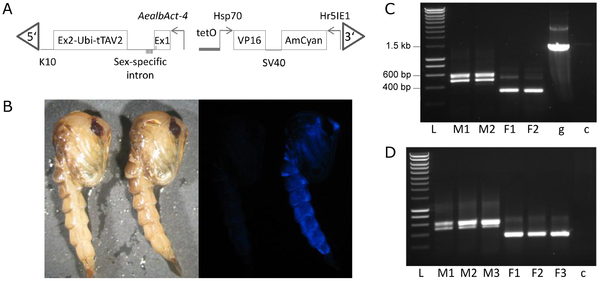A new flightless strain of the Asian tiger mosquito, Aedes albopictus, has been created by Oxitec scientists, a breakthrough that could help stop the spread of this dangerous and invasive pest.
Aedes albopictus is a serious nuisance biter, but is also capable of transmitting dengue fever, Chikungunya, West Nile Virus and a host of other diseases. In the last few decades it has spread throughout the world where it has gone from bothersome pest to increasing health concern. The Asian tiger mosquito is difficult to control using conventional methods rely; chemical pesticides harm other insects and become increasingly ineffective as mosquitoes develop resistance. An Oxitec team led by Dr Genevieve Labbe genetically modified the mosquitoes with a 'flightless' gene so that the females are unable to fly. Oxitec releases male mosquitoes carrying the flightless gene: male mosquitoes can't bite or spread diseases, and when Oxitec males mate with wild females, their flightless daughters are unable to feed or reproduce, and soon die.

A: Map of the OX4358 construct. Promoters are indicated by arrows, exons are shown as boxes, introns as horizontal lines. The engineered start codon is indicated by a bar in the Actin-4 exon 1 (Ex1), whilst stop codons in the male exon are shown by bars below the line. B: Phenotype of wild-type (left) and OX4358F1-Aal (right) pupae under white light (left panel) and blue filter (right panel). C: RT-PCR analysis of transcripts from Ae. albopictus OX4358, from two male and two female pupae (M1, M2, F1 and F2, respectively), gDNA amplification (g) and no-template control (c). L: DNA size marker (Smartladder, Eurogentec). D: RT-PCR analysis of transcripts from Ae. aegypti OX4358, from three male and three female pupae (M1, M2, M3, F1, F2, and F3 respectively) and no template control (c). Sequencing of the PCR products revealed that splicing occurs as in the native gene, except for a second male-specific transcript in which exon 1 has an extra 75 bp in both Ae. aegypti and Ae. albopictus (see text). doi:10.1371/journal.pntd.0001724.g002
Dr. Randy Gaugler, Director of the Center for Vector Biology at Rutgers University says, "The Asian tiger mosquito is an extremely aggressive biter prominent in the global surge in new and emerging vector-borne diseases. The public health threat from this mosquito, particularly with regard to transmission of dengue and chikungunya, is of concern to health professionals because there are no vaccines or chemo-prophylaxis to treat infection. Suppressing the mosquitoes that transmit the viruses is the only available approach. Conventional control strategies against this species have been moderately effective at best. A new paradigm is needed."
Commenting on the breakthrough, Oxitec Chief Scientific Officer Dr Luke Alphey said, "We believe this is an intelligent response to this invasive pest. These mosquitoes and their breeding sites are hard for humans to find, which limits the effectiveness of conventional control methods. So instead we are harnessing the natural drive of a male mosquito to seek out a female. It's not only an effective strategy but an environmentally sound one too: the mosquitoes only mate with their own species so, in contrast to pesticides, non-target insects are not harmed. Removing this mosquito would cause minimal environmental disruption, not least because it is a very recent invasive species in most areas."
The flightless mosquito strain is an adaptation of Oxitec's genetically 'sterile' mosquitoes, which have already been successfully demonstrated in Grand Cayman and Brazil, reducing target populations of the dengue mosquito, Aedes aegypti.
Citation: Labbé GMC, Scaife S, Morgan SA, Curtis ZH, Alphey L (2012) Female-Specific Flightless (fsRIDL) Phenotype for Control of Aedes albopictus. PLoS Negl Trop Dis 6(7): e1724. doi:10.1371/journal.pntd.0001724






Comments